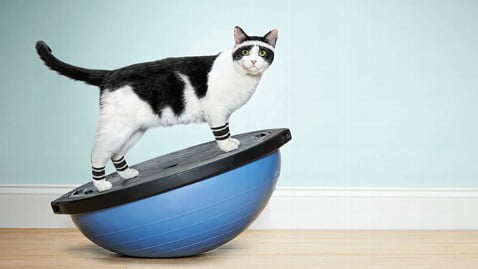Physiotherapy and rehabilitation has become highly valued within human medicine and is relatively well established overseas and now in South Africa, with regards to canines, but what about our feline masters? Their reputation precedes them as being independent or uncooperative and therefore a challenge to treat and rehabilitate, but this is not necessarily so. With the emergence of Veterinary Physiotherapy as a new Para-Veterinary profession in South Africa, the demand for effective post-surgical and injury rehabilitation for cats with physical dysfunction, is on the rise.
Physiotherapy and Rehabilitation Therapy are concerned with identifying and maximising quality of life and movement potential within the spheres of promotion, prevention, treatment / intervention, habitation and rehabilitation. Movement, function and performance are assessed and goals are agreed using unique skills.
SAAPRA (South African Animal Rehab Association)
As stated by SAAPRA, goals are patient specific and aim to eliminate pain and inflammation, reduce lameness, increase strength, muscle mass and tone, increase joint range of motion and slow down the detrimental effects of joint degeneration, in other words, increase joint health. The therapists aim is to be able to provide the animal with the ability to maintain its musculoskeletal health so that it remains as functional as possible, thereby providing the patient with an improved quality of life.
It is estimated that a third of all adult cats have Osteoarthritis (OA) by the age of 6, and up to 90% of cats over the age of 12 have some degree of OA.
Dr Karen Becker, Healthy Pets presented by Mercola
The main contributing factors to these statistics is a sedentary or inactive lifestyle and feline obesity.

Cats by nature, are adept at hiding discomfort. Being light on their feet and generally quite agile they tend to display behavioral changes rather than the typical signs of pain displayed by their canine counterparts. Signs that your cat may be experiencing pain could include weight loss, muscle atrophy (wastage), a lack of self-grooming and also hesitance to jump up or down from objects that previously posed no issue. If you are noticing these signs and symptoms then it may be time to look at a multi-modal approach with your veterinarian. Regular therapy may also result in the reduction of the use of necessary anti-inflammatory and pain medications, as the various methods used in therapy produce an analgesic effect.
Treatments are not only limited to cats with Osteoarthritis but also those with neurological dysfunction such as Intervertebral Disc Disease, orthopaedic diseases such as hip dysplasia and patella luxation, post-operative cases following fractures and amputations, and even soft tissue injuries or tendon contractures, the list goes on and on! Therapists are trained to use various modalities in the treatment of patients. This includes manual therapy in the form of massage, joint mobilizations, and fascia release, electrotherapy, laser, electromagnetic therapy and therapeutic ultrasound. Therapists also use specific rehabilitation exercises to enhance the effectiveness of their treatments and boost weight loss for their patients. At home, owners can encourage physical activity through interactive play sessions or by carrying the food bowl around the house, with kitties in tow.

Along with a biologically appropriate diet, one can also supplement their cats’ diet with a high quality omega 3 fish oil, or products with MSM, Glucosamine or Chondroitin, but take care with those cats who suffer from inflammatory bowel disease, as oral supplements may result in gastro-intestinal upsets. So turn your flabby Felix into a fit feline and offer them the chance to live their life to the fullest. Discuss an holistic approach with your attending veterinarian and don’t hesitate to contact a reputable therapist to guide you in rehabilitating your cat.

